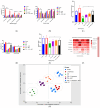Gut Microbiome Engineering for Diabetic Kidney Disease Prevention: A Lactobacillus rhamnosus GG Intervention Study
- PMID: 40563973
- PMCID: PMC12189892
- DOI: 10.3390/biology14060723
Gut Microbiome Engineering for Diabetic Kidney Disease Prevention: A Lactobacillus rhamnosus GG Intervention Study
Abstract
The gut microbiota has emerged as a critical modulator in metabolic diseases, with substantial evidence supporting its role in attenuating diabetes-related nephropathy. Recent investigations demonstrate that strategic manipulation of intestinal microflora offers novel therapeutic avenues for safeguarding renal function against diabetic complications. This investigation sought to determine the nephroprotective potential of Lactobacillus rhamnosus GG (LGG) administration in diabetic nephropathy models. Six experimental cohorts were evaluated: control, probiotic-supplemented control, diabetic, diabetic receiving probiotic therapy, diabetic with antibiotics, and diabetic treated with both antibiotics and probiotics. Diabetic conditions were established via intraperitoneal administration of streptozotocin (50 mg/kg) following overnight fasting, according to validated protocols for experimental diabetes induction. Probiotic therapy (3 × 109 CFU/kg, bi-daily) began one month before diabetes induction and continued throughout the study duration. Glycemic indices were monitored at bi-weekly intervals, inflammatory biomarkers, renal function indices, and urinary albumin excretion. The metabolic profile was evaluated through the determination of HOMA-IR and the computation of metabolic syndrome scores. Microbiome characterization employed 16S rRNA gene sequencing alongside metagenomic shotgun sequencing for comprehensive microbial community mapping. L. rhamnosus GG supplementation substantially augmented microbiome richness and evenness metrics. Principal component analysis revealed distinct clustering of microbial populations between treatment groups. The Prevotella/Bacteroides ratio, an emerging marker of metabolic dysfunction, normalized following probiotic intervention in diabetic subjects. Results: L. rhamnosus GG administration markedly attenuated diabetic progression, achieving glycated hemoglobin reduction of 32% compared to untreated controls. Pro-inflammatory cytokine levels (IL-6, TNF-α) decreased significantly, while anti-inflammatory mediators (IL-10, TGF-β) exhibited enhanced expression. The renal morphometric analysis demonstrated preservation of glomerular architecture and reduced interstitial fibrosis. Additionally, transmission electron microscopy confirmed the maintenance of podocyte foot process integrity in probiotic-treated groups. Conclusions: The administration of Lactobacillus rhamnosus GG demonstrated profound renoprotective efficacy through multifaceted mechanisms, including microbiome reconstitution, metabolic amelioration, and inflammation modulation. Therapeutic effects suggest the potential of a combined probiotic and pharmacological approach to attenuate diabetic-induced renal pathology with enhanced efficacy.
Keywords: Lactobacillus rhamnosus GG; diabetic nephropathy prevention; gut–kidney crosstalk; inflammatory regulation; metabolic modulation; microbiome engineering; reno protective mechanisms.
Conflict of interest statement
The authors declare that there are no conflicts of interest.
Figures






Similar articles
-
Amelioration of diabetic nephropathy in mice by a single intravenous injection of human mesenchymal stromal cells at early and later disease stages is associated with restoration of autophagy.Stem Cell Res Ther. 2024 Mar 5;15(1):66. doi: 10.1186/s13287-024-03647-x. Stem Cell Res Ther. 2024. PMID: 38443965 Free PMC article.
-
Enhancement of oxaliplatin efficacy and amelioration of intestinal epithelial damage by Lactobacillus rhamnosus GG through modulation of gut microbiota.Front Microbiol. 2025 Jun 30;16:1565880. doi: 10.3389/fmicb.2025.1565880. eCollection 2025. Front Microbiol. 2025. PMID: 40661984 Free PMC article.
-
Probiotics for the prevention of pediatric antibiotic-associated diarrhea.Cochrane Database Syst Rev. 2011 Nov 9;(11):CD004827. doi: 10.1002/14651858.CD004827.pub3. Cochrane Database Syst Rev. 2011. Update in: Cochrane Database Syst Rev. 2015 Dec 22;(12):CD004827. doi: 10.1002/14651858.CD004827.pub4. PMID: 22071814 Updated.
-
Lactobacillus rhamnosus GG Modulates Mitochondrial Function and Antioxidant Responses in an Ethanol-Exposed In Vivo Model: Evidence of HIGD2A-Dependent OXPHOS Remodeling in the Liver.Antioxidants (Basel). 2025 May 23;14(6):627. doi: 10.3390/antiox14060627. Antioxidants (Basel). 2025. PMID: 40563263 Free PMC article.
-
Probiotics for management of functional abdominal pain disorders in children.Cochrane Database Syst Rev. 2023 Feb 17;2(2):CD012849. doi: 10.1002/14651858.CD012849.pub2. Cochrane Database Syst Rev. 2023. PMID: 36799531 Free PMC article.
References
-
- Ishfaq M., Hu W., Hu Z., Guan Y., Zhang R. A review of nutritional implications of bioactive compounds of Ginger (Zingiber officinale Roscoe), their biological activities and nano-formulations. Ital. J. Food Sci. 2022;34:1–12. doi: 10.15586/ijfs.v34i3.2212. - DOI
-
- Fernández-Pampin N., González Plaza J.J., García-Gómez A., Peña E., Rumbo C., Barros R., Martel-Martín S., Aparicio S., Tamayo-Ramos J.A. Toxicology assessment of manganese oxide nanomaterials with enhanced electrochemical properties using human in vitro models representing different exposure routes. Sci. Rep. 2022;12:20991. doi: 10.1038/s41598-022-25483-w. - DOI - PMC - PubMed
LinkOut - more resources
Full Text Sources

